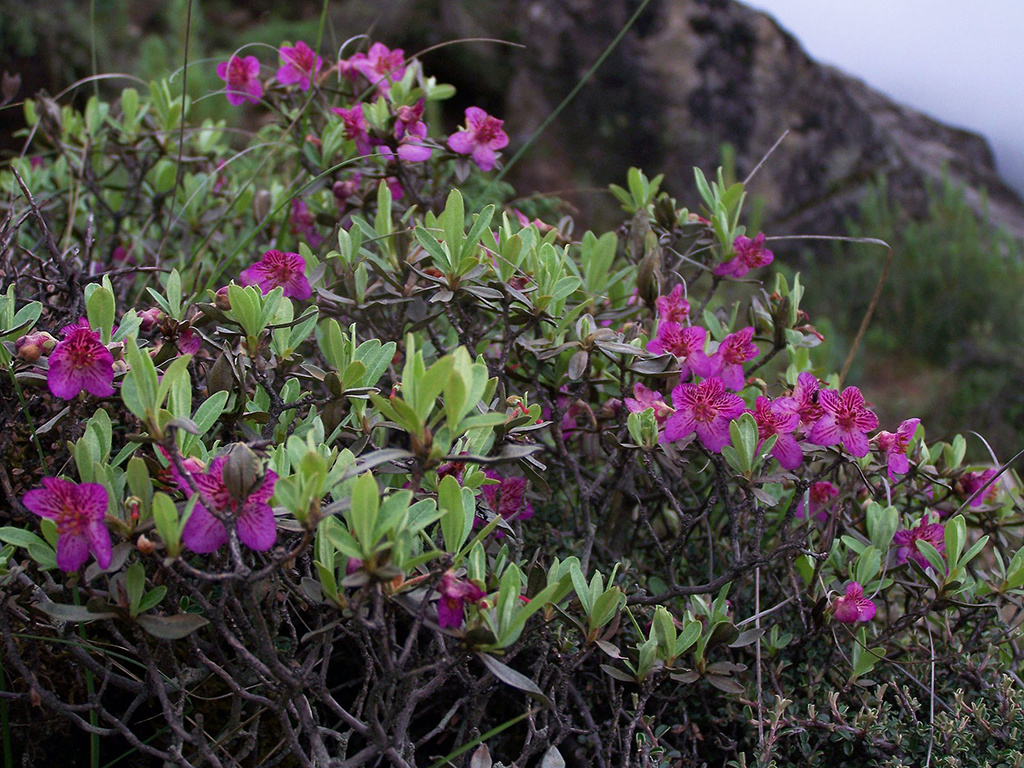
Nepal
Rhododendron
Rhododendron

General Description / Cultural Significance
Nepal resides along the southern slopes of the Himalayan mountains, a rugged, fertile landlocked country. Rhododendron, Rhododendron, is the national flower of Nepal, widely recognized as one of the most important plants with over thirty different species growing throughout the country. During blooming season between March and May, the mountainsides blossom with color and it is common practice to walk through the forests and pick bouquets of Rhododendron flowers for decorating homes, as women’s hair adornments, to save as gifts, and in preparation for weddings and celebrations. Leaves of the R. lepidotum and R. anthopogum are used to make an incense whose scent pervades the Buddhist monasteries of Nepal. Raw petals of the Rhododendron are eaten, eagerly beloved by children who enjoy the sweetness of their nectar. A sweet drink is concocted from the flowers and the Raute and Chepang people of Nepal pickle the flowers to eat with rice and curry dishes. R. cinnabarinum is used to flavor spirits and jams throughout the region.
The Rhododendron genus is highly regarded for its essential oil, which is used to scent perfumes and cosmetics. Extract of R. thomsonii is considered a natural insecticide and can be toxic to human beings. Traditional Nepalese herbalism tells of a cure for dysentery made from Rhododendron flowers ground into a powder, mixed with the starch from boiled rice, and eaten by patients. To treat headaches and skin diseases, a paste is created from the plant’s leaves and applied to the forehead. The bark’s extract is known to heal coughs and petals are crushed and utilized to absorb the blood from nose bleeds. Rhododendron’s many healing functions stem from the plant’s abundance of flavonoids, saponins, and phenolic compounds.
Climate Change / Conservation Status
The blooming of Rhododendrons traditionally herald the start of spring for Nepal and the Himalayan region. Lately, an increase in earth’s temperatures and changing rainfall patterns has begun to disrupt this annual ritual in a disturbing warning of the ever-impending impacts of climate change.
More than three quarters of Nepal’s people live in rural areas, surviving off subsistence farming on a small scale. Their isolation in varied and challenging topography has left rural Nepalese incredibly vulnerable in the face of climate induced violent weather storms which cause flooding, landslides, soil erosion, and drought. This destruction begets more destruction in the form of forest fires which consume local farms, villages, and biodiversity.
Extreme weather events perpetrated by climate change have revealed just how isolated and vulnerable much of the Nepalese population is. They are often unable to receive communication during storms, to evacuate when conditions are deadly, and to receive food and medicine relief. Because of this, the most important climate adaptations being developed in Nepal aim to address the country’s extreme isolation in an attempt for the Nepalese to have transportation during storms, to save their money in secure banks, and to communicate with the rest of the country.
Flash floods and violent surges of rainfall are affecting the mountainside habitats in which Rhododendron grows, crushing the plant under rushing waters and uprooting its soil. Meanwhile, climate change is causing invasive species to thrive in Nepal, a phenomenon which is decreasing native biodiversity and stifling the distribution and health of flora such as Rhododendron. Native plants such as Rhododendron are indicators of ecosystem health. This means that the plant’s behavior, now blooming earlier than normal from early February to mid-March, is a direct indication of climate change taking effect on plant physiology. This phenomenon is affecting other important cultural and medicinal plants as well. Aconitum heterophyllum, a critical natural remedy for the common cough, indigestion, and diarrhea, has advanced its flowering period by nearly a month. Shifts in flowering patterns set off a disruption in the seasonal behavior of pollinators, insects, and animals alike, and can trickle down to affect agriculture and local farming, a tradition critical to Nepal’s culture and survival. Should important plants such as the Rhododendron continue to be harmed, local people who suffer from economic isolation and access to basic needs would lose a free and natural source of medicine and food. This is critical to understood how interconnected Nepal is to its ecosystem, how linked the Nepalese are to the Rhododendron, and why it is so vital that aromatic plants be conserved and climate change be reversed.
Alternate Names
Azalea
Sources
Dixit, A., n.d. Climate Change in Nepal: Impacts and Adaptive Strategies. World Resources Institute. [website]
EcoWatch, 2017. Early Bloom of Rhododendrons in Himalayas Linked to Climate Change, Scientists Say. Eco Watch. [website]
Mission of the Kingdom of Nepal to the United Nations. This statement can be found on the World Sensorium original website.
Shobhapaudel, 2011. Magical uses of Rhododendron: National flower of Nepal. All Voices. [website]
Shrethsa, U.B., 2018. Potential impact of climate change on the distribution of six invasive alien plants in Nepal. Ecological Indicators, 95, pp.99–107.
Uniyal, S.K., et al., 2006. Traditional use of medicinal plants among the tribal communities of Chhota Bhangal, Western Himalaya. Journal of Ethnobiology and Ethnomedicine. (2)14 DOI: 10.1186/1746-4269-2-14
World Bank Group, 2022. Nepal. Climate Change Knowledge Portal. [website]

